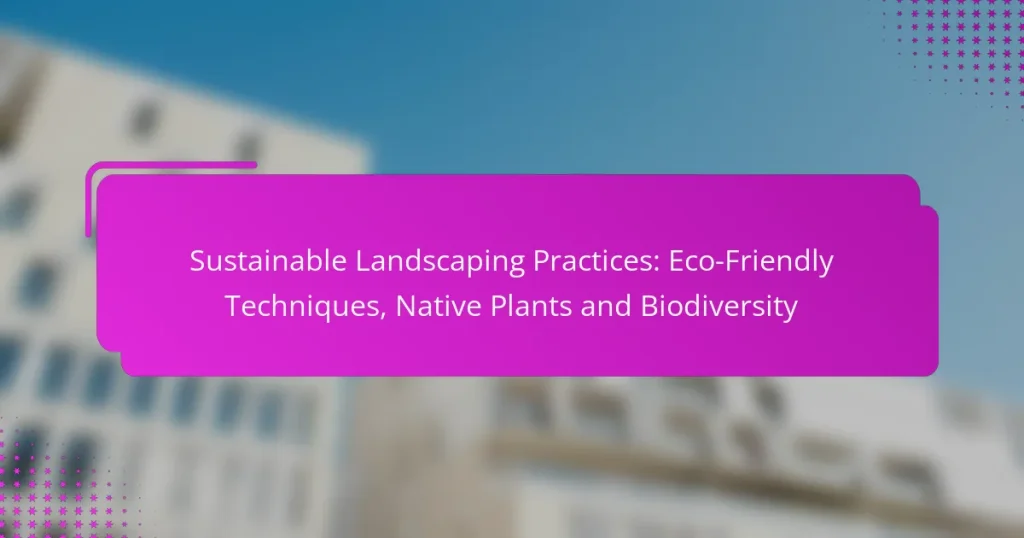Sustainable landscaping practices aim to reduce environmental impact while enhancing the aesthetic and functional qualities of outdoor spaces. By incorporating native plants, utilizing rainwater harvesting, and employing organic pest control, these eco-friendly techniques promote biodiversity and create resilient ecosystems. This approach not only supports local wildlife but also minimizes maintenance needs and conserves valuable resources.

What are the best sustainable landscaping practices?
The best sustainable landscaping practices focus on minimizing environmental impact while enhancing the beauty and functionality of outdoor spaces. Key techniques include using native plants, harvesting rainwater, composting, employing organic pest control, and improving soil health.
Use of native plants
Using native plants is a cornerstone of sustainable landscaping. These plants are adapted to local climates and soils, requiring less water and maintenance compared to non-native species. They also support local wildlife, including pollinators, which are crucial for biodiversity.
When selecting native plants, consider local ecosystems and choose species that thrive in your specific area. Resources like local nurseries or botanical gardens can provide guidance on the best options for your region.
Rainwater harvesting
Rainwater harvesting involves collecting and storing rainwater for irrigation and other uses, reducing dependence on municipal water supplies. This practice can significantly lower water bills and promote water conservation, especially in regions prone to drought.
To implement rainwater harvesting, install a rain barrel or a more extensive cistern system to capture runoff from roofs. Ensure that the system is properly filtered to keep debris out and check local regulations regarding rainwater use.
Composting techniques
Composting is an effective way to recycle organic waste into nutrient-rich soil amendments. This practice reduces landfill waste and enhances soil fertility, promoting healthier plant growth. A well-maintained compost pile can break down materials like kitchen scraps and yard waste in a few months.
To start composting, choose a designated area or bin, layer green materials (like vegetable scraps) with brown materials (like dried leaves), and turn the pile regularly to aerate it. Avoid adding meat, dairy, or oily foods to prevent odors and pests.
Organic pest control
Organic pest control focuses on managing pests without synthetic chemicals, promoting a healthier ecosystem. Techniques include introducing beneficial insects, using natural repellents, and practicing crop rotation to disrupt pest life cycles.
Common organic methods include neem oil, insecticidal soap, and diatomaceous earth. Always monitor pest populations and apply treatments only when necessary to maintain a balanced environment.
Soil health improvement
Improving soil health is essential for sustainable landscaping, as healthy soil supports robust plant growth and reduces the need for fertilizers. Practices such as adding organic matter, practicing crop rotation, and minimizing soil disturbance can enhance soil structure and fertility.
Consider conducting a soil test to determine nutrient levels and pH. Based on the results, amend the soil with compost or other organic materials to create a thriving landscape that requires fewer inputs over time.

How can native plants enhance biodiversity?
Native plants play a crucial role in enhancing biodiversity by providing essential habitats and food sources for local wildlife. By incorporating these plants into landscaping, you can create a thriving ecosystem that supports various species and promotes ecological balance.
Attracting local wildlife
Native plants are specifically adapted to local climates and soils, making them more resilient and beneficial for local wildlife. They provide shelter and food for birds, insects, and other animals, which helps maintain healthy populations. For example, planting native shrubs can attract songbirds, while flowering plants can draw in butterflies and bees.
To maximize wildlife attraction, consider using a mix of native species that bloom at different times throughout the growing season. This ensures a continuous food supply for various creatures, enhancing the overall biodiversity of your landscape.
Supporting pollinators
Native plants are vital for supporting pollinators like bees, butterflies, and hummingbirds. These species rely on specific flowers for nectar and pollen, and native plants often provide the best resources. Incorporating a variety of native flowering plants can significantly increase the number of pollinators in your garden.
Choose plants that bloom at different times to create a year-round habitat for pollinators. Avoid using pesticides, as they can harm these beneficial insects. Instead, focus on creating a diverse planting scheme that encourages a healthy pollinator population.
Reducing water usage
Native plants typically require less water than non-native species, making them an excellent choice for sustainable landscaping. Their deep root systems allow them to access moisture from the soil more efficiently, reducing the need for supplemental irrigation. This is particularly beneficial in regions prone to drought.
To further reduce water usage, group plants with similar water needs together and use mulch to retain soil moisture. Implementing these practices can lead to significant water savings while promoting a healthy, biodiverse landscape.

What eco-friendly landscaping techniques can reduce maintenance?
Eco-friendly landscaping techniques can significantly lower maintenance needs by promoting natural growth and minimizing resource use. These methods often focus on water conservation, soil health, and the use of native plants, which require less intervention and are better suited to local conditions.
Mulching for moisture retention
Mulching is an effective technique for retaining soil moisture and reducing the need for frequent watering. By applying a layer of organic or inorganic material around plants, you can help regulate soil temperature and suppress weed growth.
Common mulching materials include wood chips, straw, and shredded leaves. Aim for a mulch depth of about 2-4 inches to maximize benefits while allowing water to penetrate the soil. Regularly check and replenish the mulch as needed to maintain its effectiveness.
Permeable paving options
Permeable paving allows rainwater to infiltrate the ground, reducing runoff and promoting groundwater recharge. This technique is particularly beneficial in urban areas where traditional paving can lead to flooding and erosion.
Consider options such as permeable concrete, porous asphalt, or interlocking pavers with gaps filled with gravel or grass. These materials can help manage stormwater while providing durable surfaces for walkways and driveways. Ensure proper installation to maintain permeability over time.
xeriscaping principles
Xeriscaping is a landscaping approach designed to reduce water use, especially in arid regions. It involves selecting drought-tolerant plants and using design techniques that minimize irrigation needs.
Key principles of xeriscaping include grouping plants with similar water requirements, using mulch to retain moisture, and incorporating efficient irrigation systems like drip lines. This method not only conserves water but also creates a low-maintenance landscape that thrives in local conditions.

How to choose the right plants for sustainable landscaping?
Choosing the right plants for sustainable landscaping involves selecting species that thrive in your local environment, require minimal resources, and support local biodiversity. Focus on native plants, as they are adapted to the local climate and soil, and provide habitat for local wildlife.
Understanding local climate
Local climate plays a crucial role in plant selection for sustainable landscaping. Consider factors such as temperature ranges, rainfall patterns, and seasonal changes. For instance, regions with hot summers and cold winters may require plants that can withstand temperature fluctuations and drought conditions.
Research climate zones in your area, which can guide you in selecting plants that are well-suited to thrive without excessive watering or maintenance. Resources like the USDA Plant Hardiness Zone Map can help you identify suitable species.
Assessing soil types
Soil type significantly influences plant health and growth. Conduct a soil test to determine pH levels, nutrient content, and drainage capabilities. Sandy soils drain quickly but may require more frequent watering, while clay soils retain moisture but can lead to root rot if not properly managed.
Choose plants that are compatible with your soil type. For example, native grasses often thrive in sandy soils, while wildflowers may flourish in clay-rich areas. Amending soil with organic matter can improve its structure and fertility, supporting a wider range of plants.
Evaluating sunlight exposure
Sunlight exposure is essential for plant growth and should be assessed before planting. Observe your landscape throughout the day to identify areas of full sun, partial shade, and full shade. Most plants have specific light requirements, and matching these with your garden’s conditions is key to success.
For sunny areas, consider drought-resistant plants like succulents or native wildflowers. In shadier spots, opt for shade-tolerant species such as ferns or hostas. A simple rule of thumb is to group plants with similar light needs together to create a thriving ecosystem.

What are the benefits of sustainable landscaping in urban areas?
Sustainable landscaping in urban areas offers numerous benefits, including enhanced environmental quality and improved community well-being. By incorporating eco-friendly techniques and native plants, cities can foster biodiversity and create healthier living spaces.
Improved air quality
Sustainable landscaping contributes to improved air quality by increasing the number of plants that absorb carbon dioxide and release oxygen. Native plants, in particular, are well-adapted to local conditions and require less water and maintenance, making them ideal for urban environments.
Incorporating trees and shrubs can significantly reduce air pollutants, such as particulate matter and volatile organic compounds. A well-planned landscape can lower pollution levels by up to 30%, benefiting public health and enhancing the overall urban atmosphere.
Urban heat island mitigation
Urban heat islands occur when cities experience higher temperatures than surrounding rural areas due to human activities and infrastructure. Sustainable landscaping helps mitigate this effect by increasing vegetation cover, which cools the air through shade and evapotranspiration.
Implementing green roofs, planting trees, and using permeable materials can lower surface temperatures by several degrees. For example, a well-placed tree can reduce temperatures in its vicinity by up to 10°F (about 5°C), making urban areas more comfortable during hot weather.

